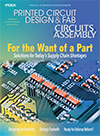Sensors: The Unsung Catalyst Behind AI’s Value
 Amid AI hype, true progress depends on the accuracy of sensor-driven data collection.
Amid AI hype, true progress depends on the accuracy of sensor-driven data collection.
While the world is flummoxed over the up-and-down nature of tariffs and the political drama they create, one bright spot in the news the past year or so, and impacting our industry more than any, is artificial intelligence, or AI.
Indeed, if your investment portfolio lacks an AI stock, or your customer base doesn’t include a player in the AI world, pundits believe you are missing the boat. But I keep thinking, what exactly powers the boat?
As I observe the excitement swirling around this ballyhooed, already prominent next-wave technology, I keep thinking about the real value it adds. Has any product touted as artificial had or produced value? Intelligence, yes, is coveted and does create value, but not by itself. To wit, in the early years of my career, I often heard the adage, “garbage in, gospel out!” And in many ways that remains true even when the input comes from intelligence. Plenty of brilliant people over the centuries have done anything but offer, create or generate value. Possibly we all overlook the real “value-add” that enables AI: sensors.
We in electronics manufacturing – whether designing boards, or fabricating and assembling them – have long relied on sensors as our enabling technology. Take the most basic example, the temperature sensor. It started with someone sticking their finger in a heated solution and saying, “Hot!”
That evolved from mercury thermometers, which could provide data in tens of seconds, to digital thermometers, which reported findings in seconds. Now, we have highly sensitive microprocessor-driven sensing devices that communicate changes in temperature in a second, or faster.
It gets better. Today, thanks in part to the technology our industry has enabled, sensors measure and image a whole host of amazing dimensions, temperatures, pressures, thicknesses, purities and speed through plating systems, imagers, drills, routers and more.
The same applies to sensors in non-manufacturing environments. In a typical visit to a medical office, staff accesses the data they need – say, an insurance card, or information from a previously seen doctor – staff scan the data so they can use it when and as needed. When it is time to pay for that appointment, a device reads the sensor-driven credit card with a simple tap.
Or, if purchasing a new gadget, large or small, or curious what’s on a restaurant’s menu, pull out a cellphone and scan the QR code. Voilà, the information is at your fingertips.
Sensors come in different types. A temperature sensor has a specific appearance and operates with particular firmware, while a pressure sensor looks and operates differently, just like scanners, QR codes and others. The one thing all sensors have in common is that they collect data, ranging from large and bulky to nano size. Additionally, they benefit from tremendous technology that has enabled their evolution from primitive tools, like mercury thermometers, to the most advanced sensors imaginable.
When AI is touted as a game-changer, I return to the “garbage in, gospel out” adage. AI is of value only if it collects and analyzes accurate data. This makes the importance and value of the sensors that deliver the information possibly the real critical catalyst of AI, and where the real value is created.
Yes, AI is most often associated with the creation of algorithms to locate and then slice and dice data, and thousands of server farms are employed to do just that. But have you ever opened a search engine, typed in a subject and read the AI-generated answer just to chuckle at what came back? Clearly, wherever AI chose to pull the information from had an inferior sensor that produced inaccurate or marginally accurate information.
AI can be a powerful tool that everyone should learn to harness to assist in their professional as well as personal life. Especially in manufacturing, the ability to refine processes and improve yield and quality while building smaller, more technologically advanced product can make AI a true game-changer.
Don’t forget the sensor that compiles the data that drives AI, however. In the world of AI, a bad sensor can create the “garbage in” that becomes “gospel out.”
has more than 30 years’ experience as a PCB executive, most recently as president of FTG Circuits Haverhill; peterbigelow@msn.com. He is vice chair of the PCB Management Symposium: Navigating through Turbulent Times, taking place Sept. 30 at PCB West.
Press Releases
- Altus Reports Growing Demand for Guidance on Convection Reflow Oven Specification
- Coherix Opens New Adhesive-Dispensing Vision Center in Europe
- Pan Pacific Strategic Electronics Symposium Program Finalized
- The Most Critical 2 Inches in SMT Manufacturing – When a Splice Fails, the Line Fails, Full Stop. Throughput and Yield Depend on One Overlooked Moment







